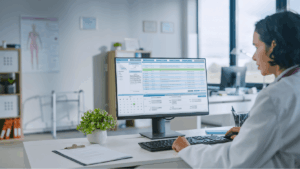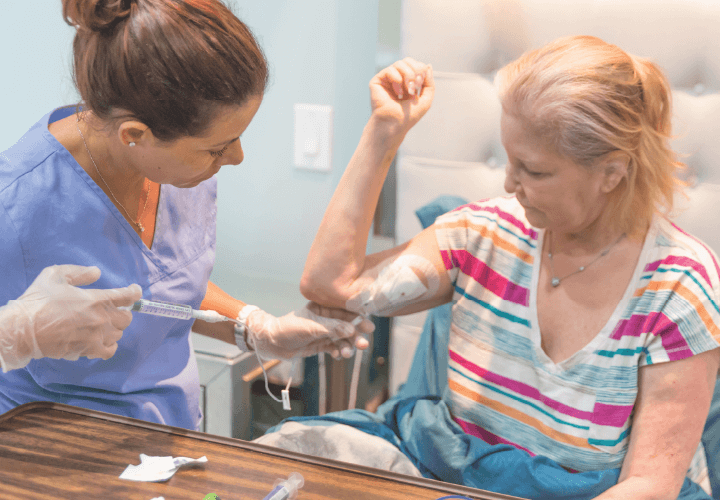- 3 MIN READ
3 Wound Measurement Techniques Explained: A Guide for Accurate Wound Assessment
Accurate wound measurement plays a vital role in wound care and management. Whether documenting a

Share:
Accurate wound measurement plays a vital role in wound care and management. Whether documenting a new wound, monitoring healing progress, or adjusting treatment plans, wound measurement provides critical data that supports clinical decision-making.For healthcare professionals, using consistent and precise wound measurement techniques ensures more accurate documentation and better communication among care teams, and supports improved patient outcomes.
This guide explains three commonly used wound measurement techniques, their advantages, limitations, and when their use may be most appropriate.
Disclaimer: This blog is for informational purposes only and does not constitute medical advice. Always consult with a qualified healthcare professional for wound care management.
Why Wound Measurement is Critical in Clinical Practice
Wound measurement is a foundational component of wound care. While at first glance it may appear to be a simple documentation task, accurate wound measurement plays a crucial role in nearly every aspect of wound assessment, management, and healing outcomes. Consistent and standardized measurement practices ensure that clinicians can track a wound’s progression, identify potential complications, and develop appropriate treatment plans — all while supporting continuity of care across healthcare settings.
The Role of Wound Measurement in Patient Care
Monitoring Healing Progress Over Time
One of the most important functions of wound measurement is that it provides healthcare providers with the ability to use objective data to track healing. Wounds naturally change in size, depth, and appearance as the healing process progresses. Regular and consistent measurement allows healthcare providers to:
- Determine whether a wound is healing as expected
- Detect changes in wound size, depth, and tissue quality
- Establish trends in healing, such as reduction in wound dimensions or increased granulation tissue
- Determine if healing is occurring within expected timeframes based on wound type and patient factors
Monitoring this data over time provides valuable insight into whether current wound care interventions are effective or if adjustments are needed.
Detecting Early Signs of Complications
Accurate wound measurement is also essential for identifying early warning signs of wound complications. When a wound fails to decrease in size over time — or worse, increases in size—it may signal potential issues, including:
- Localized infection
- Increased exudate production
- Ischemia or poor perfusion
- Undermining or tunneling
- Necrotic tissue development
- Stalled healing due to comorbidities or inadequate treatment
Detecting these signs early allows for timely interventions, which can prevent further complications, reduce patient discomfort, and potentially avoid more invasive procedures.
Supporting Accurate Documentation for Clinical Records and Billing
In addition to supporting clinical decision-making, wound measurement plays an important role in healthcare documentation and billing. Accurate and detailed wound documentation is required for:
- Maintaining complete patient health records
- Meeting regulatory and accreditation standards
- Supporting reimbursement from insurance providers or government health plans
- Providing legal documentation of care provided
Incorrect or inconsistent wound measurements may lead to discrepancies in patient records, delays in reimbursement, or challenges in communicating care progress to other providers.
Facilitating Communication Across Care Teams
Wound care often involves interdisciplinary collaboration between physicians, nurses, wound care specialists, and other allied health professionals. Standardized wound measurements help ensure that everyone involved in the patient’s care has a clear, consistent understanding of:
- The wound’s current status
- The goals of treatment
- The progress or setbacks in healing
This is especially important in settings where patients may transition between care teams — such as moving from hospital care to home health services — where continuity of care is essential.
Guiding Treatment Decisions and Dressing Selection
Wound measurement directly informs treatment strategies, including dressing selection, topical therapies, and advanced wound care interventions. The size, depth, and characteristics of a wound can influence:
- The type of dressing required (e.g., absorptive, antimicrobial, moisture-retentive)
- The frequency of dressing changes
- The need for adjunctive therapies like negative pressure wound therapy
- The consideration of debridement or advanced wound care products
- Referrals to wound care specialists or multidisciplinary teams
Without accurate measurement data, developing an effective treatment plan becomes significantly more difficult, increasing the risk of prolonged healing times or complications.
Challenges in Wound Measurement
Despite its importance, wound measurement can be challenging due to:
- Irregular or asymmetrical wound shapes
- Variability between clinicians’ measurement techniques
- Potential for human error
- Limitations of certain tools or methods
These challenges make it even more critical to use standardized measurement techniques consistently.
Overview of Wound Measurement Best Practices
Accurate wound measurement begins with more than just choosing the right technique. It depends on how consistently and carefully the technique is performed. Whether using a ruler, a transparent tracing sheet, or advanced imaging software, applying standardized best practices ensures that every measurement supports better documentation, communication, and ultimately, better patient care.
General Principles for Measuring Wounds
Before any measurement is taken, the wound must be cleansed thoroughly according to clinical protocol. This helps remove debris, exudate, or biofilm that could obscure wound edges or interfere with measurement. A clean wound surface allows for more accurate visualization of wound dimensions.
Consistency is equally important. Clinicians should measure the same wound using the same technique, tools, and orientation at each assessment. For example, length should always be recorded as the longest measurement in the head-to-toe direction, and width as the longest perpendicular measurement to the length. This consistency allows clinicians to reliably track progress over time.
The standard documentation format for wound dimensions is length x width x depth, recorded in centimeters or millimeters. In many clinical settings, this format is preferred in electronic health records for its clarity and universality.
While wound size is a critical metric, a complete assessment should also include undermining, tunneling, periwound condition, and the types of tissue visible in the wound bed. The amount, color, and consistency of exudate—along with the condition of the surrounding skin—can offer additional clinical insight and should be documented where appropriate.
Tools Commonly Used in Wound Measurement
Wound measurement doesn’t require complex tools, but having the right equipment can greatly improve accuracy. Paper or plastic disposable rulers, often found in wound care kits, are used to measure length and width. These rulers are marked in millimeters and centimeters, and designed for single-use to reduce cross-contamination.
Depth is typically measured with a sterile, cotton-tipped applicator, gently inserted into the deepest point of the wound. The applicator is then held against a ruler to determine the depth.
For wounds with irregular shapes, clinicians may use transparent measuring guides or tracing films. These sterile, flexible sheets are laid gently over the wound and used to trace the perimeter. Some include printed measurement grids to help calculate surface area.
More advanced practices may incorporate digital wound measurement systems. These tools use photography or 3D scanning to capture an image of the wound and automatically calculate dimensions. Many digital systems also store the wound’s history and generate trend reports, offering a more detailed view of healing over time.
Technique #1: Linear Measurement
What Is the Linear Method?
The linear method remains the most widely used approach in clinical wound assessment. This technique involves measuring the length, width, and depth of the wound, typically using a ruler and a cotton-tipped applicator. It is especially effective for regularly shaped wounds—such as circular, oval, or rectangular ulcers—and is recommended in numerous wound care education resources and facility protocols.
How It’s Performed
After cleansing the wound and preparing the surrounding area, the clinician identifies the longest measurement in the head-to-toe direction, which is recorded as the length. The width is then measured at the widest point perpendicular to the length. Finally, depth is assessed by gently inserting a sterile applicator into the deepest area of the wound bed, marking the point of contact, and measuring the distance with a ruler. Measurements are then documented in the format length x width x depth (e.g., 4 cm x 2 cm x 1 cm).
Strengths and Limitations
The linear method is fast, simple, and doesn’t require specialized tools. It is well-suited for routine documentation and for facilities that need to perform frequent assessments with limited time or resources. However, this technique may not capture the true dimensions of wounds that have irregular contours. It also doesn’t provide data on surface area or volume, which may be important for more complex cases. Variability can occur between clinicians, particularly if anatomical landmarks aren’t interpreted consistently.
Technique #2: Wound Tracing
What Is the Wound Tracing Method?
Wound tracing provides a more detailed view of wound shape by capturing its perimeter onto a transparent surface. This method is particularly useful for irregularly shaped wounds that are not accurately represented by linear dimensions alone. By creating a visual outline, tracing allows for a more precise calculation of wound surface area and facilitates the monitoring of small changes in shape over time.
How It’s Performed
To perform this technique, the clinician cleanses the wound and places a sterile transparent film over it without applying pressure. Using a sterile marker, the clinician traces the edges of the wound directly onto the film. This tracing can then be placed over graph paper or input into software to calculate the total area in square centimeters. Documentation should include the measured area and any significant changes since the last tracing.
Strengths and Limitations
Tracing is especially helpful for pressure injuries, burns, and surgical wounds that do not follow uniform shapes. It allows for a high degree of accuracy when surface area is a key metric in determining healing progress. However, the technique requires additional materials and sterile procedures, and can be more time-consuming than the linear method. Tracings must also be properly stored or scanned into the patient record, which may not be feasible in every setting.
A study published in the Journal of Wound, Ostomy and Continence Nursing (JWOCN) supports wound tracing as a valuable tool for improving measurement accuracy in complex wounds.
Technique #3: Digital Wound Measurement
What Is Digital Wound Measurement?
Digital wound measurement tools use imaging technology to capture and analyze wounds through photography or 3D scanning. These systems not only calculate wound length, width, and depth but often also determine area and, in some cases, volume. Many tools incorporate software that stores measurements, generates healing progress charts, and even detects tissue types in the wound bed.
How It Works
Using a smartphone or specialized camera, a clinician captures a calibrated image of the wound. The software then analyzes this image to calculate dimensions. The data is stored digitally, allowing for easy tracking over time. Some systems offer additional functionality, including 3D models, remote sharing for consultations, and integration into electronic medical records.
Strengths and Limitations
Digital wound measurement improves accuracy, particularly in complex or irregular wounds. It also reduces inter-clinician variability and facilitates standardized documentation across large healthcare systems. Digital tools are particularly helpful in telehealth or remote monitoring scenarios.
However, these systems do require initial investment and training. Access to the necessary technology may be limited in some care settings, and measurement accuracy can depend on proper image capture and device calibration. Despite these limitations, digital methods are gaining popularity as they align with broader shifts toward data-driven healthcare.
For more on this approach, the NIH study on wound measurement technology offers additional insights into how these tools are shaping modern wound care.
Other Considerations in Wound Measurement
While length, width, and depth provide essential information about a wound’s size, they don’t tell the whole story. Comprehensive wound assessment also involves identifying features beneath the skin’s surface and observing the condition of the surrounding tissue. Documenting characteristics like undermining, tunneling, tissue type, and periwound appearance provides clinicians with a more complete understanding of the wound — helping guide appropriate treatment decisions and monitor healing progress over time.
Measuring Undermining and Tunneling
Undermining and tunneling are wound characteristics that extend beneath the skin’s surface and should be documented separately from wound size.
How to Measure:
- Use the “clock face” method to describe the location of undermining or tunneling (e.g., undermining from 3 o’clock to 6 o’clock).
- Measure depth using a sterile cotton-tipped applicator.
Documenting Wound Appearance
In addition to size, wound assessment should include:
- Periwound skin condition (e.g., maceration, erythema)
- Tissue types present (e.g., granulation, slough, eschar)
- Exudate amount and characteristics
- Presence of odor or signs of infection
These details provide a complete picture of wound status and guide treatment planning.
Choosing the Right Wound Measurement Technique
Not every wound is the same — and neither is the best way to measure it. Selecting the most appropriate wound measurement technique depends on several factors, including the wound’s shape, depth, and location, as well as the tools available and the clinician’s experience.
Choosing the right approach helps ensure accuracy, while using that technique consistently over time allows for reliable tracking of healing progress and more informed care decisions.
Factors to Consider
Selecting the appropriate wound measurement technique depends on:
- Wound shape and size
- Location and depth of the wound
- Availability of tools and resources
- Clinical setting (acute care, long-term care, home care)
- Clinician skill and training
Explore this guide from the Wound Care Education Institute (WCEI) for more insights on selecting the best measurement technique for specific wounds.
Importance of Consistency
Whichever technique is chosen, consistency is key. Using the same technique for a specific wound throughout its healing process ensures reliable comparison of data over time.
The Bottom Line
Accurate wound measurement is a critical part of wound assessment and care planning. The three primary techniques — linear measurement, wound tracing, and digital tools — each offer unique benefits and considerations.
Healthcare professionals play a key role in selecting the appropriate technique and ensuring consistent, accurate documentation to support patient healing.
Reminder: This blog is intended for informational purposes only. Always consult with a qualified healthcare professional for wound assessment and care decisions.
Frequently Asked Questions
What is the most common technique for wound measurement?
The linear method (length x width x depth) is the most widely used wound measurement technique because it is fast, simple, and requires minimal equipment.
How often should wounds be measured?
Wound measurement frequency depends on facility guidelines but is commonly performed at every dressing change or at least weekly, especially for chronic wounds.
Are digital wound measurement tools more accurate?
Digital tools can enhance accuracy, especially for irregularly shaped wounds, but their effectiveness depends on proper calibration, clinician training, and technology reliability.
Can wound measurement impact treatment decisions?
Yes. Accurate wound measurements help track healing progress, detect complications early, and guide appropriate treatment strategies, including dressing selection and potential referrals.
Speak With a Healthcare Professional
If you have questions about wound measurement or wound care options, speak with a qualified healthcare provider. Proper wound assessment is essential for effective treatment and healing.
Explore Wound Care Solutions with Covalon
For Healthcare Professionals:
Discover how Covalon’s advanced wound care solutions are designed to support optimal wound protection and healing outcomes. Learn more about our products and how they can aid in wound management.
For Patients:
Speak with your healthcare provider to discuss appropriate wound care solutions and to learn if Covalon’s wound care products are right for your care plan.
Covalon
If you are an individual reading this, please consult your health care provider before making any health care decisions, for guidance about a specific medical condition, and for use of any specific products. Covalon expressly disclaims responsibility and shall have no liability for any damages, loss, injury, or claim whatsoever suffered as a result of your reliance on any of the material or information contained in its blog articles or on the website
Related Blogs
Getting an IV is a common and relatively minor medical..
Intravenous (IV) therapy is a common medical procedure that involves..
The role of bedside nursing is becoming increasingly important as..








